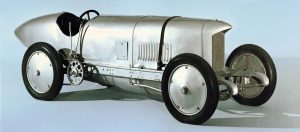The early days of motor sport
Motor racing was an important driver of vehicle sales, even in the early years of the automobile. “Win on Sunday”” sell on Monday” was a maxim recognised by even the earliest automotive pioneers. Yet although the Daimler Motor Company took full advantage of this potential right from the beginning, building up a reputation for powerful and reliable vehicles through its racing and record-breaking activities, its then rival Benz & Cie was initially more cautious in this respect. Carl Benz himself appears to have been little convinced of the promotional power of motor sport. The early part of the 20th century brought a change of attitude, however, and Benz & Cie went on to take part in a wide range of notable events – achieving considerable success in the process.

Benz Grand Prix racing car, 1908
Benz & Cie’s involvement in motor sport will be an original Grand Prix racing car of 1908. Newly developed for that season, the company in fact sent three vehicles to the French Grand Prix. The result was outstanding: Benz drivers Victor Hemery and Rene Hanriot took second and third places, while Benz was the only brand to have all three of its vehicles finish the race. Only Christian Lautenschlager in a Mercedes was faster, winning the race and so helping to deliver a threefold victory for Germany.
Technical data
- Year of construction: 1908
- Cylinders: 4
- Displacement: 12,060 cc
- Output: 120 hp (88 kW) at 1,500 rpm
- Top speed: 163 km/h

Benz 200 hp “Lightning Benz” racing car, 1909
One of the key goals in those early years of the 20th century was to break the then magic speed barrier of 200 km/h. Benz was the first company to do so, with a petrol-engine automobile: the 200 hp racing car took to the track at the Brooklands circuit in England in 1909, achieving an average speed of 202.7 km/h. This record-breaking racing car, with its massive four-cylinder engine, would however go on to achieve its greatest successes in Florida/USA. In 1911, Bob Burman reached the amazing speed of 228.1 km/h on the sand track at Daytona Beach, so making the “Lightning Benz”, as the model became known in the US, the fastest vehicle in the world’s faster even than any aeroplane or train. It was a record that would remain unbeaten for eight years.
Technical data
- Year of construction: 1909
- Cylinders: 4Â
- Displacement: 21,504 cc
- Output: 200 hp (147 kW) at 1,600 rpm
- Top speed: 228 km/h

Benz “Prince Henry Car”, 1910
In the early years of the last century, the “Prince Henry Trial” was one of the most well-known motor sport events in Germany. Automobile enthusiast Prince Henry of Prussia, brother of the then German Emperor, Wilhelm II, donated the prize money for a competitive touring car rally in 1907 and the first Trial was held in 1908. Benz took part in the third event in the early summer of 1910 with a total of ten completely new-built special tourers, four of them with a displacement of 5.7 litres and six with 7.3 litres. The vehicles featured a cardan drive system and an aerodynamically optimised body with a characteristic pointed rear end.
As far as is known, they are also the only two Benz vehicles still in existence that actually took part in that legendary long-distance rally. The car with the starting number 36 was driven by Fritz Erle and is owned these days by the Louwman Museum. The touring car with the starting number 38, from the Mercedes-Benz Classic collection, was once driven by Carl Neumaier. Both cars have undergone a process of meticulous restoration to return them to their original condition and now gleam once again in their original dark green paintwork. Not just one, but two vehicles from those very early days of motoring are thus once again ready to be driven and admired. Also in 1910, just a few weeks after the Prince Henry Rally, both these vehicles went on to take part in the Tsar Nicholas Rally over a distance of 3,000 kilometres from St Petersburg via Kiev and Moscow and back to St Petersburg.
Technical data
- Year of construction: 1910
- Cylinders: 4
- Displacement: 5,715 cc
- Output: 80 hp (59 kW)
- Top speed: 126 km/h
Gallery




You must be logged in to post a comment.